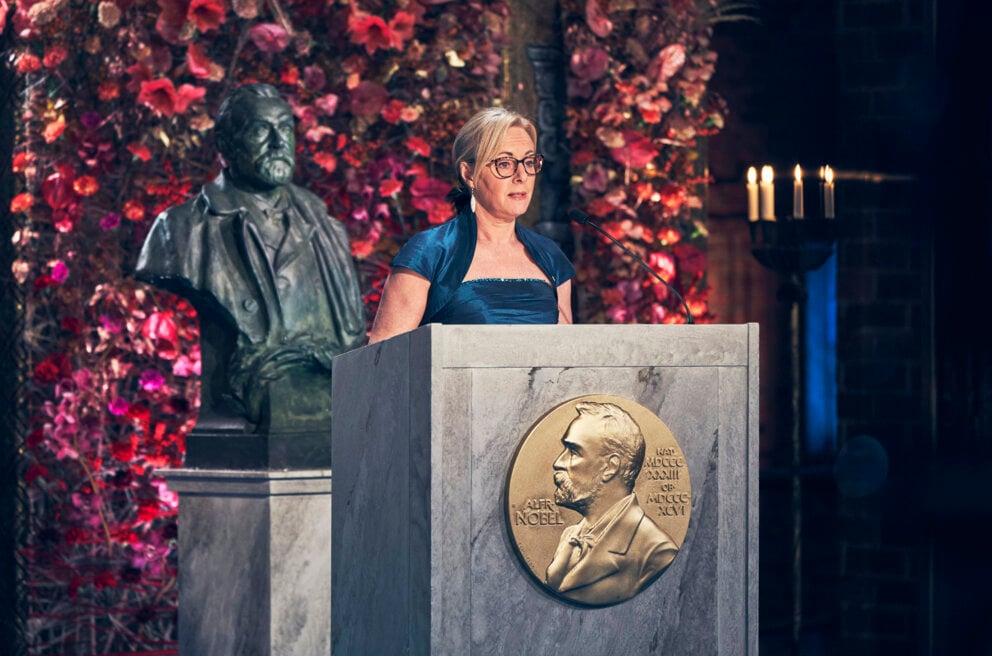Award ceremony speech

Professor Professor Gunilla Karlsson Hedestam delivering the presentation speech for the 2020 Nobel Prize in Physiology or Medicine.
© Nobel Prize Outreach. Photo: Dan Lepp
English
Swedish
Presentation Speech by Professor Gunilla Karlsson Hedestam, Member of the Nobel Assembly at Karolinska Institutet, Member of the Nobel Committee for Physiology or Medicine, 10 December 2020
Majesties, your Royal Highnesses, Esteemed Laureates, Ladies and Gentlemen,
Viruses have always been part of our existence. Through evolution, we have acquired versatile functions to handle invading pathogens. This has equipped us with a finely tuned and, in most cases, a highly effective immune system that protects us against daily threats. Different kinds of life forms, bacteria, plants and animals, and different species of these, have their own unique set of viral intruders that circulate within the given population. But new threats continuously arise. Viruses often cross species barriers to increase their host range and spread more effectively, which is their sole reason to exist.
While we cannot see viruses with the naked eye, we know that they come in many different shapes and forms, and they frequently take us by surprise. This year, the world is facing a viral pandemic that affects almost every aspect of our society. The expeditious identification of the causative virus, SARS CoV-2, was unprecedented and our understanding of the virus and the disease it causes is increasing by the day. Progress towards the goal of containing the pandemic is now being made.
Hosting this year’s Nobel Prize ceremony in the absence of the Laureates is one of many consequences of the pandemic, but one which also highlights the significance of this year’s Nobel Prize in Physiology or Medicine: the discovery of the Hepatitis C virus, a major human pathogen and the causative agent of a much more invisible pandemic.
The work performed by the Laureates spans several decades and illustrates the importance of scientific collaboration and systematic experimentation, using both traditional and emerging technologies. The starting point was the observation that an increasing number of individuals who had received blood transfusions developed chronic liver inflammation years later. The clinical course of the disease was different from that seen after infection with the known hepatitis viruses. This was a silent condition, which rarely gave symptoms in the initial phase, but resulted in progressive damage of the liver over time in most infected individuals.
Dr. Harvey Alter set out to investigate the new disease. Through carefully designed studies of samples from blood donors and individuals who developed this form hepatitis, he laid the puzzle. In 1978, Alter formally demonstrated that the disease was transmissible, and the race to identify the causative agent could start.
Around this time, molecular biology-based techniques had become increasingly available, but they were nowhere near as efficient as they are today. Dr. Michael Houghton and his team set out to clone the unknown virus using a novel screening technique. Almost against all odds, given the limitations of the techniques at the time, the screen was successful and resulted in the isolation of the Hepatitis C virus.
Dr. Charlie Rice immediately embarked on studies to define how the virus copies itself in our cells to make new infectious particles. By defining the details of this process, he could generate a virus clone that alone induced productive infection and liver disease. This provided the final evidence that the Hepatitis C virus caused the new form of blood-borne hepatitis.
The discovery of the Hepatitis C virus by this year’s Laureates laid the foundation for our current understanding about how the virus survives in its niche during the long chronic phase of the infection, and how liver disease develops. And importantly, it led to the development of highly effective anti-viral medicines that now cure the infection in almost all treated persons.
This year’s Nobel Prize in Physiology or Medicine puts viruses at center stage. Viruses will continue to surprise us. They exploit different routes of transmission and are masters at adaptation. To be prepared for new viral threats, we need research such as that performed by this year’s Laureates, and we need a deep appreciation of fundamental aspects of different types of viruses and their interactions with the host.
On behalf of the Nobel Assembly at Karolinska Institutet, it is my great privilege to convey to you our warmest congratulations.
Copyright © The Nobel Foundation 2020
Nobel Prizes and laureates
Six prizes were awarded for achievements that have conferred the greatest benefit to humankind. The 12 laureates' work and discoveries range from proteins' structures and machine learning to fighting for a world free of nuclear weapons.
See them all presented here.
